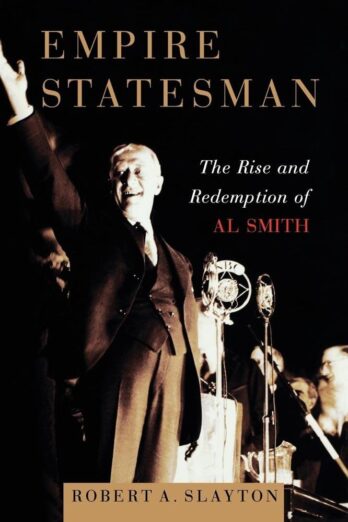Books Reviewed
Alfred E. Smith was featured recently in two PBS documentary series, New York and The Irish in America. Yet he is all but unknown today, even within the Democratic Party he once led. Smith has been called the most underappreciated political figure in 20th century America. Indeed, the last proper biography of Smith, and the only one still in print, was published in 1958. Robert A. Slayton attempts to remedy this neglect with Empire Statesman: The Rise and Redemption of Al Smith.
Smith was the first politician of national stature to rise from the ranks of urban immigrants, in his case, the Irish-American immigrants of downtown Manhattan. He became a four-term governor of New York and, in 1928, the first Roman Catholic to win a major party’s presidential nomination.
His accomplishments at the helm of the Empire State far surpass those of Theodore or Franklin Roosevelt. Smith’s policies did not bring the state to financial ruin, as did the reckless spending programs of later governor Nelson Rockefeller, a nominal Republican. It is arguable that no governor since Al Smith has actually improved the administration of taxpayer dollars in New York State.
Slayton, a professor of history at Chapman University in Orange, California, emphasizes the importance of Smith as an inclusive and tolerant politician, taking “diversity” in America in the direction it ought to go—E pluribus unum. Slayton contrasts Smith’s style with that of Smith’s Massachusetts contemporary, James Michael Curley, who traded on ethnic resentments and, in doing so, stalled economic development in Boston for decades, leaving his state a political Yugoslavia-on-the-Charles. We take for granted that this multiethnic disaster did not also befall New York, but it is Al Smith who deserves much of the credit.
The author carefully documents the role of religious bigotry in costing Smith the 1928 presidential election. The Ku Klux Klan was an important but unacknowledged part of the Democratic coalition at that time. The KKK and its sympathizers turned, with full force and shameless libel, against Smith. One widely circulated flyer showed a picture of the construction then underway on the Holland Tunnel and identified it as a secret passageway for Smith to bring the Pope to Washington to rule.
* * *
Just by laying out the record, Slayton goes far to debunk the principal modern liberal smear against Smith: that bitterness over the national success of Franklin Roosevelt in 1932 turned Smith into a kind of anti-liberal crank who reflexively opposed the New Deal because he was jealous of Roosevelt. While Smith was undeniably bitter that the White House had been snatched by a man he considered a dilettante, Smith remained one of the most farsighted public figures of the 1930s. His public denunciation of Hitler and the Nazis within months of Hitler’s ascent to power in 1933 made him the first prominent American political leader to take such a stand.
Slayton makes too much of the fact that many of Smith’s allies opposing the New Deal were wealthy and powerful, as if the quality of ideas is a function of the income of those holding them. But Slayton recognizes that much of Smith’s pointed, public objections to Roosevelt’s policies were rooted in Smith’s understanding that many actions proper and constitutional for a state government are not proper for the federal government.
Al Smith’s defeat in 1928 had terrible consequences for both political parties. The winner was Herbert Hoover, who, as Slayton notes, was seen as “far and away the most liberal” of the potential Republican candidates that year. As president, Hoover dealt with the financial crisis of 1929 by reversing the low-tax policies of Calvin Coolidge, which turned a short, painful financial crisis into a long, painful depression for the first time in U.S. history. The GOP did not really recover until the election of Ronald Reagan in 1980.
The magnitude of the drubbing Smith took in 1928 meant that when voters were ready to elect a Democratic president, the choice would not be Smith but his successor as New York governor, FDR. Roosevelt failed to bring unemployment down until World War II did the job for him, but he succeeded in entrenching the Democrats as the party of a big-spending administrative state on the Progressive model for generations to come.
Smith did believe in regulating business where he found it necessary, as in the aftermath of the 1911 Triangle Shirtwaist fire, in which 146 women died because their employer had locked the exits to keep workers at their sewing machines. But it is inconceivable that Al Smith of Tammany Hall, where politics and social services were an organic whole, would as President have built such a bureaucratic edifice as Roosevelt did, detached to the greatest extent possible from the vagaries of popular governance.
The difference between the liberalism of Al Smith and that of FDR also explains why Roosevelt’s hagiographers have gone to such lengths to smear the later Al Smith as a reactionary. A liberal of unquestionable credentials who understood federalism and who consequently hated the New Deal could not be allowed to exist as an honorable figure.

